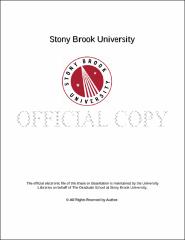| dc.identifier.uri | http://hdl.handle.net/11401/76318 | |
| dc.description.sponsorship | This work is sponsored by the Stony Brook University Graduate School in compliance with the requirements for completion of degree. | en_US |
| dc.format | Monograph | |
| dc.format.medium | Electronic Resource | en_US |
| dc.language.iso | en_US | |
| dc.publisher | The Graduate School, Stony Brook University: Stony Brook, NY. | |
| dc.type | Thesis | |
| dcterms.abstract | Nanostructured materials have attracted a growing attention as a novel solution of enlarging capacity and efficiency of energy storage devices. As a result, characterization of nanostructured materials is of paramount importance. Development of electron microscopy renders a practical method to observe and analyze nanostructured materials. In this thesis, two dimensional and three dimensional electron microscopy characterizations have been used to investigate nanomaterials. The nanostructured materials studied in this thesis are core-shell structured FeNiPt nanorods(NRs), NiO nanosheets and DNA origami linked nanoassemblies. I characterized the atomic-scale structures of shape-controlled ternary alloy nanocatalysts (Pt-Fe-Ni nanorods) using annular dark-field scanning transmission electron microscopy (ADF-STEM). The elemental distribution within the nanorods were obtained using spatially resolved electron energy loss spectroscopy (EELS). Our results suggested the Pt-Fe-Ni nanorods have a core-shell structure with Pt rich in the shell and, Fe and Ni rich in core. The controlleds structure of Pt-Fe-Ni NRs are suggested to account for the superior activity for oxygen reduction reaction (ORR) reaction. I investigated the lithiation processes of NiO nanosheets using in situ TEM. We observed two reaction modes. With real time tracking, I was able to quantify the propagation rate of the reaction front in both reaction modes. It was found the front propagation rate of the lateral reaction mode is approximately 100 times faster than that of the core-shell reaction. This work directly unravels the spatially dependent reaction pathways in lithium-ion battery electrodes. To improve the throughput of electron tomography, we have established a model based tomographic method that only relies on the projected centroids of the nanoparticles and bypasses the image intensity. This method only requires 5-10 tilt images and it is useful for calibrating a TEM goniometer and field/scan distortions. In this thesis, I will demonstrate this new method with the reconstruction of a DNA origami linked nanoassembly. | |
| dcterms.available | 2017-09-20T16:50:01Z | |
| dcterms.contributor | Su, Dong | en_US |
| dcterms.contributor | Orlov, Alexander | en_US |
| dcterms.contributor | Xin, Huolin. | en_US |
| dcterms.creator | Li, Jing | |
| dcterms.dateAccepted | 2017-09-20T16:50:01Z | |
| dcterms.dateSubmitted | 2017-09-20T16:50:01Z | |
| dcterms.description | Department of Materials Science and Engineering. | en_US |
| dcterms.extent | 40 pg. | en_US |
| dcterms.format | Monograph | |
| dcterms.format | Application/PDF | en_US |
| dcterms.identifier | http://hdl.handle.net/11401/76318 | |
| dcterms.issued | 2015-08-01 | |
| dcterms.language | en_US | |
| dcterms.provenance | Made available in DSpace on 2017-09-20T16:50:01Z (GMT). No. of bitstreams: 1
Li_grad.sunysb_0771M_11819.pdf: 1103167 bytes, checksum: 88538e3736721d2e5fbd224791c4f2aa (MD5)
Previous issue date: 2014 | en |
| dcterms.publisher | The Graduate School, Stony Brook University: Stony Brook, NY. | |
| dcterms.subject | Materials Science | |
| dcterms.title | 2D and 3D TEM Imaging on Nano-materials for Energy Application | |
| dcterms.type | Thesis | |

